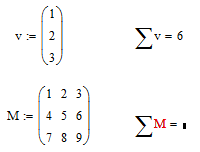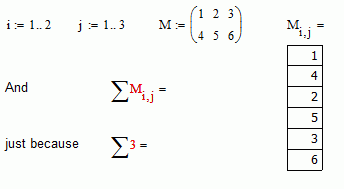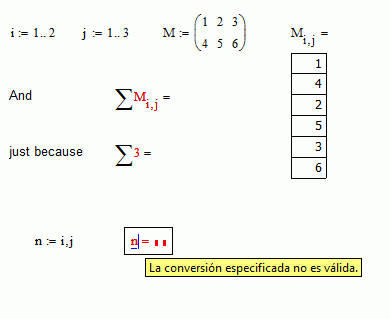Community Tip - If community subscription notifications are filling up your inbox you can set up a daily digest and get all your notifications in a single email. X
- Subscribe to RSS Feed
- Mark Topic as New
- Mark Topic as Read
- Float this Topic for Current User
- Bookmark
- Subscribe
- Mute
- Printer Friendly Page
Why??? Sum vector and matrix in prime
- Mark as New
- Bookmark
- Subscribe
- Mute
- Subscribe to RSS Feed
- Permalink
- Notify Moderator
- Labels:
-
Other
Accepted Solutions
- Mark as New
- Bookmark
- Subscribe
- Mute
- Subscribe to RSS Feed
- Permalink
- Notify Moderator
Because the summation operator without indices is designed to work only with vectors and ranges, not with matrices.
It's been that way in Mathcad also:

It also doesn't accept pure numbers:

But I would fully agree with you that there is no compelling reason to limit the summation operator in this way. Especially because the mean function accepts all:

Luc
- Mark as New
- Bookmark
- Subscribe
- Mute
- Subscribe to RSS Feed
- Permalink
- Notify Moderator
Because the summation operator without indices is designed to work only with vectors and ranges, not with matrices.
It's been that way in Mathcad also:

It also doesn't accept pure numbers:

But I would fully agree with you that there is no compelling reason to limit the summation operator in this way. Especially because the mean function accepts all:

Luc
- Mark as New
- Bookmark
- Subscribe
- Mute
- Subscribe to RSS Feed
- Permalink
- Notify Moderator
LucMeekes написал(а):
But I would fully agree with you that there is no compelling reason to limit the summation operator in this way. Especially because the mean function accepts all:
Luc
One more bad limitation (Net v jizni schact'ia!)
- Mark as New
- Bookmark
- Subscribe
- Mute
- Subscribe to RSS Feed
- Permalink
- Notify Moderator
Luc_Meekes-disabled wrote in 2008:
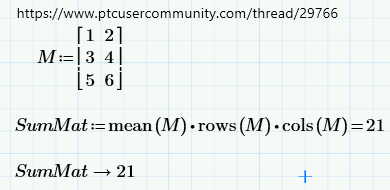
- Mark as New
- Bookmark
- Subscribe
- Mute
- Subscribe to RSS Feed
- Permalink
- Notify Moderator
Viktor Korobov wrote:
Luc_Meekes-disabled wrote in 2008:
That's a neat method from Luc.
Here's a messier, but still fundamentally matrix, program way ...

Stuart
- Mark as New
- Bookmark
- Subscribe
- Mute
- Subscribe to RSS Feed
- Permalink
- Notify Moderator
I must have had a bright moment there...
Luc
- Mark as New
- Bookmark
- Subscribe
- Mute
- Subscribe to RSS Feed
- Permalink
- Notify Moderator
LucMeekes wrote:
I must have had a bright moment there...
Luc
Merely but one of many, Luc! Success! ![]()
- Mark as New
- Bookmark
- Subscribe
- Mute
- Subscribe to RSS Feed
- Permalink
- Notify Moderator
LucMeekes wrote:
Because the summation operator without indices is designed to work only with vectors and ranges, not with matrices.
It's been that way in Mathcad also:
It also doesn't accept pure numbers:
But I would fully agree with you that there is no compelling reason to limit the summation operator in this way. Especially because the mean function accepts all:
Luc
I'm surprised at you, Valery. Seems to work for me.
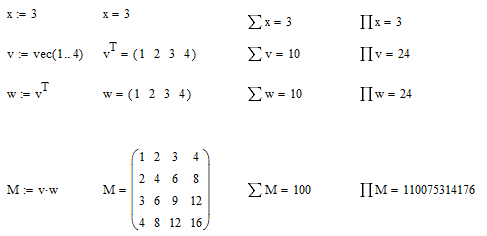
![]()
Stuart
- Mark as New
- Bookmark
- Subscribe
- Mute
- Subscribe to RSS Feed
- Permalink
- Notify Moderator
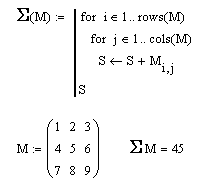
- Mark as New
- Bookmark
- Subscribe
- Mute
- Subscribe to RSS Feed
- Permalink
- Notify Moderator
Valery, it looks to me that your trick won't work with scalars and nested matrices - right?
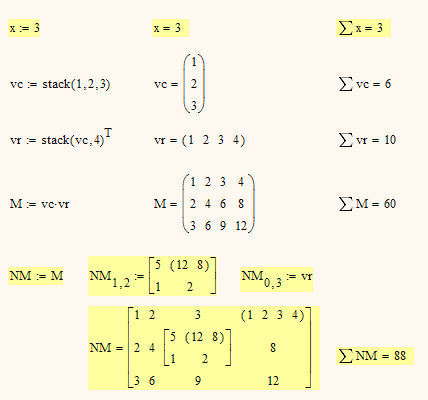
![]()
Werner
- Mark as New
- Bookmark
- Subscribe
- Mute
- Subscribe to RSS Feed
- Permalink
- Notify Moderator
Werner Exinger wrote:
Valery, it looks to me that your trick won't work with scalars and nested matrices - right?
Werner
Ah! Decisions, decisions ...
given

this ...

or this ...

or this ...

Stuart
- Mark as New
- Bookmark
- Subscribe
- Mute
- Subscribe to RSS Feed
- Permalink
- Notify Moderator
StuartBruff wrote:
Ah! Decisions, decisions ...
Yes. life is hard!
I took the easy way

- Mark as New
- Bookmark
- Subscribe
- Mute
- Subscribe to RSS Feed
- Permalink
- Notify Moderator
Sorry!
The talk is not about Mathcad 15 - about Prime!
- Mark as New
- Bookmark
- Subscribe
- Mute
- Subscribe to RSS Feed
- Permalink
- Notify Moderator
Valery Ochkov wrote:
Sorry!
The talk is not about Mathcad 15 - about Prime!
I was just answering to your post from Sep 27, 2016 11:45 AM where you showed your tricky solution in Mathcad 15 ![]()
Guess we all know that what you would like to do only works in your Mathcad PM (or whatever you would call it now).
Luc already gave the correct answer to your question "Why???". Its because the sum operator simply isn't implemented that way and never was. Maybe it should be, but it isn't. You are free to open a support case with PTC and hope the best, but I wouldn't hold my breath waiting for a solution.
- Mark as New
- Bookmark
- Subscribe
- Mute
- Subscribe to RSS Feed
- Permalink
- Notify Moderator
Hi
Werner Exinger wrote:
... Luc already gave the correct answer to your question "Why???". Its because the sum operator simply isn't implemented that way and never was. ...
I guess that probably isn't that simple. For me it's more related about that there are not range matrices, there are only range vectors. Also with two range variables can't index a matrix in the "natural" or "expected" way.
With range matrices it could be easy extend a lot of vector operators.
Best regards.
Alvaro.

- Mark as New
- Bookmark
- Subscribe
- Mute
- Subscribe to RSS Feed
- Permalink
- Notify Moderator
AlvaroDíaz wrote:
Hi
Werner Exinger wrote:
... Luc already gave the correct answer to your question "Why???". Its because the sum operator simply isn't implemented that way and never was. ...
I guess that probably isn't that simple. For me it's more related about that there are not range matrices, there are only range vectors.
...
With range matrices it could be easy extend a lot of vector operators.
Could you please expand on what you mean by a "range matrix", Alvaro?
.... Also with two range variables can't index a matrix in the "natural" or "expected" way.
This is yet another long-standing request (in one form or another). I posted a workround last year and I've got a semi-smart pick function that also provides similar functionality.
Re: How to extract non-consecutive submatrix in a easier way
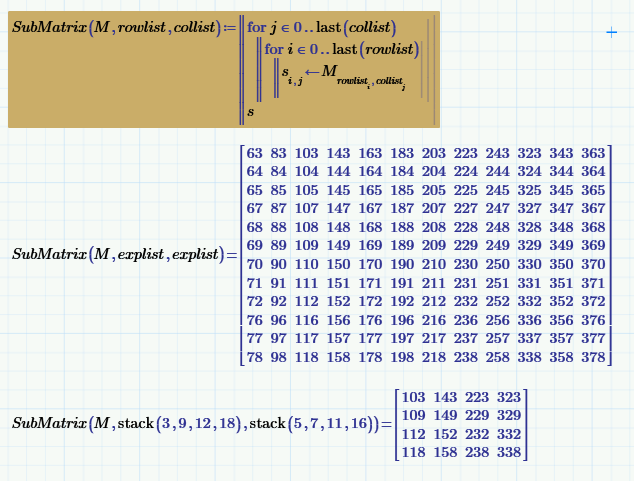
Stuart
- Mark as New
- Bookmark
- Subscribe
- Mute
- Subscribe to RSS Feed
- Permalink
- Notify Moderator
Hi Stuart.
Something like n:=i,j
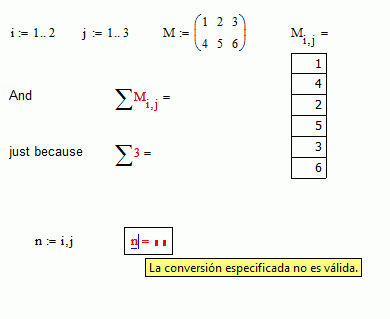
Even not pretty sure if that way is correct, what can I say is that a "matrix range" can be write expanding columns in this strange range variable input way:
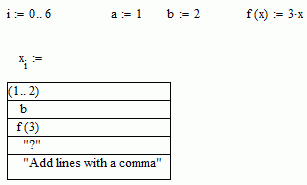
Best regards.
Alvaro.
- Mark as New
- Bookmark
- Subscribe
- Mute
- Subscribe to RSS Feed
- Permalink
- Notify Moderator
AlvaroDíaz wrote:
Hi Stuart.
Something like n:=i,j
Even not pretty sure if that way is correct, what can I say is that a "matrix range" can be write expanding columns in this strange range variable input way:
Best regards.
Alvaro.
Ah. I think what you're suggesting is akin to my Very Long-Standing Request to formalize the sequence as a type, where a sequence is an expression of the form
a,b,c,d,(e,f..g),h, etc,etc
This would allow such expressions as you want, plus allowing an easy extension of it to Multi Dimensional Array (MDA) indexing (A[i,j,k), and I wouldn't want it limited to just numbers - strings would also be allowed. For example, in the image below, s gives an example of how a numeric sequence might look, with parentheses bounding ranges; A shows how indexing might be achieved with a sequence (if each of the variables is itself a range variable, then I'd expect Mathcad to simply extend how it does 2D indexing); and the program shows that Mathcad can already handle such sequences when they form the value list for a for expression (note in particular, the two strings, the explicit ranges and the range variables are all evaluated - it's a shame Mathcad doesn't expand string ranges).
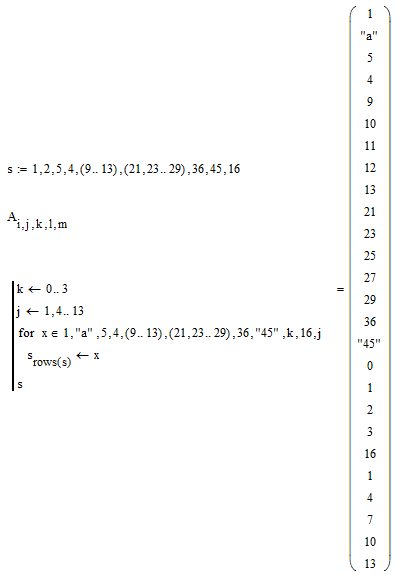
Stuart
- Mark as New
- Bookmark
- Subscribe
- Mute
- Subscribe to RSS Feed
- Permalink
- Notify Moderator
StuartBruff wrote:
Ah. I think what you're suggesting is akin to my Very Long-Standing Request to formalize the sequence as a type, where a sequence is an expression of the form
a,b,c,d,(e,f..g),h, etc,etc
This would allow such expressions as you want, plus allowing an easy extension of it to Multi Dimensional Array (MDA) indexing (A[i,j,k), and I wouldn't want it limited to just numbers - strings would also be allowed. For example, in the image below, s gives an example of how a numeric sequence might look, with parentheses bounding ranges; A shows how indexing might be achieved with a sequence (if each of the variables is itself a range variable, then I'd expect Mathcad to simply extend how it does 2D indexing); and the program shows that Mathcad can already handle such sequences when they form the value list for a for expression (note in particular, the two strings, the explicit ranges and the range variables are all evaluated - it's a shame Mathcad doesn't expand string ranges).
Interestingly, "sequence" is how Mathcad defines such structures in XML. Here's the XML for the sequence in the previous message:
<ml:program>
<ml:localDefine>
<ml:id xml:space="preserve">k</ml:id>
<ml:range>
<ml:real>0</ml:real>
<ml:real>3</ml:real>
</ml:range>
</ml:localDefine>
<ml:localDefine>
<ml:id xml:space="preserve">j</ml:id>
<ml:range>
<ml:sequence>
<ml:real>1</ml:real>
<ml:real>4</ml:real>
</ml:sequence>
<ml:real>13</ml:real>
</ml:range>
</ml:localDefine>
<ml:for>
<ml:id xml:space="preserve">x</ml:id>
<ml:sequence>
<ml:real>1</ml:real>
<ml:str xml:space="preserve">a</ml:str>
<ml:real>5</ml:real>
<ml:real>4</ml:real>
<ml:parens>
<ml:range>
<ml:real>9</ml:real>
<ml:real>13</ml:real>
</ml:range>
</ml:parens>
<ml:parens>
<ml:range>
<ml:sequence>
<ml:real>21</ml:real>
<ml:real>23</ml:real>
</ml:sequence>
<ml:real>29</ml:real>
</ml:range>
</ml:parens>
<ml:real>36</ml:real>
<ml:str xml:space="preserve">45</ml:str>
<ml:id xml:space="preserve">k</ml:id>
<ml:real>16</ml:real>
<ml:id xml:space="preserve">j</ml:id>
</ml:sequence>
<ml:localDefine>
<ml:apply>
<ml:indexer/>
<ml:id xml:space="preserve">s</ml:id>
<ml:apply>
<ml:id xml:space="preserve">rows</ml:id>
<ml:id xml:space="preserve">s</ml:id>
</ml:apply>
</ml:apply>
<ml:id xml:space="preserve">x</ml:id>
</ml:localDefine>
</ml:for>
<ml:id xml:space="preserve">s</ml:id>
</ml:program>
As an aside, it would be useful if factor (or some of the other symbolic functions) returned their results as sequence (or, at least, a vector) ... again, a very-long-standing request to make the symbolic results more useful.
Stuart
- Mark as New
- Bookmark
- Subscribe
- Mute
- Subscribe to RSS Feed
- Permalink
- Notify Moderator
Hi Stuart.
What can I say? I'm take a look too into the xml but don't found nothing interesting. You do.
Best regards.
Alvaro.
- Mark as New
- Bookmark
- Subscribe
- Mute
- Subscribe to RSS Feed
- Permalink
- Notify Moderator
Hi Stuart.
StuartBruff wrote:
Ah. I think what you're suggesting is akin to my Very Long-Standing Request to formalize the sequence as a type, where a sequence is an expression of the form
a,b,c,d,(e,f..g),h, etc,etc
This would allow such expressions as you want, plus allowing an easy extension of it to Multi Dimensional Array (MDA) indexing (A[i,j,k), ...
Yep. But problem here is that I understand only in part your big develop of the MDA. And also understand in parts the issues that ranges introduces in Mathcad, and I'm only use them for plots, and not every times. For this reason, after found this strange notation for ranges, now I can define precisely what is a range matrix: anything with more than one column in this other range definition. Before of that, I know that an indexation of a MDA with A[i,j,k intruduce some kind of range matrix, but can't prove it, and I'm not pretty sure if this kind of range matrix could be only two range variables in the implementation of a Mathcad internal library for MDA's.
About what you say about strings, sorry, give me a couple of weeks or more to fully understand it.
Best regards.
Alvaro.
- Mark as New
- Bookmark
- Subscribe
- Mute
- Subscribe to RSS Feed
- Permalink
- Notify Moderator
StuartBruff wrote:
... This is yet another long-standing request (in one form or another). I posted a workround last year and I've got a semi-smart pick function that also provides similar functionality.
But here there are not a "Feature Request" anymore sub forum. Maybe you're interesting in see this, from a Feature request sub forum: Extracting matrix from a matrix .
Best regards.
Alvaro.
PD: Power users group subsists? Or it was substituted by a kind of Power customers? I don't imagine the owners (this is, the true Mathcad customers) of Techint, Shell, General Electric, those big enterprises with a lot of engineers, posting they ideas into this forum.
- Mark as New
- Bookmark
- Subscribe
- Mute
- Subscribe to RSS Feed
- Permalink
- Notify Moderator
AlvaroDíaz wrote:
StuartBruff wrote:
... This is yet another long-standing request (in one form or another). I posted a workround last year and I've got a semi-smart pick function that also provides similar functionality.
But here there are not a "Feature Request" anymore sub forum. Maybe you're interesting in see this, from a Feature request sub forum: Extracting matrix from a matrix .
Ah yes. Very responsive. ... I'm not entirely convinced that dropping range variables was a good idea, though - a range variable takes up a few bytes of memory whilst the equivalent vector could potentially take up gigabytes (1..10E9).
PD: Power users group subsists? Or it was substituted by a kind of Power customers? I don't imagine the owners (this is, the true Mathcad customers) of Techint, Shell, General Electric, those big enterprises with a lot of engineers, posting they ideas into this forum.
"Power Users" was a private Mathsoft Collaboratory forum, created to get feedback from a variety of experienced / influential users. It was intended as a sort of direct "face to face" discussion place with Mathsoft's staff, and was definitely *not* intended as a alternative to the main Mathcad Colloboratory forum.
I don't know whether PTC has an equivalent forum. It would be ... disappointing ... if the expert Mathcad users from the big enterprises only posted in some "Premier League" Community, and deprived the rest of the user base of their talents and ideas.
Stuart
- Mark as New
- Bookmark
- Subscribe
- Mute
- Subscribe to RSS Feed
- Permalink
- Notify Moderator
StuartBruff wrote:
... I don't know whether PTC has an equivalent forum. ...
Stuart
Hi Stuart.
Maybe I don't explain well (Well, that's more than much probably). What I was observed is a change in the words from PTC. Before, we all are "users", but now, there are a lot of "customers" in the PTC mathcad blogs, posts, etc. Users maybe don't own a copy of Mathcad, but, are users ... they are who use Mathcad. When an enterprise buy a software, they establish some encouraged people, but usually those people are not necessary the final users, are technical guys, that's right, but in most cases from the IT department, and have not much idea about for what the true users are doing with the software. And that's ok, they don't need to know that. I know that PTC have their own marketing strategies, and don't need at all to discuses them with me. I'm just making the appointment about my impression of this marketing policy. And, regarding this, think about who can be called for the equivalent of the old Power Users forum. If the strategy point to customers, not the users, then, ¿who are those customers? If an university or big enterprise it's a Mathcad customer, then about who are talking in PTC blogs when they refer to them. ¿To the actionist of the university or the enterprise?
Hope that explain better what I'm saying.
Best regards.
Alvaro.@
PD: Two examples, there are more:
From this link, Notice how the inverviewed change the words
Q: I understand this feature comes as a response to user feedback. Is that right?
McGough: Yes. In fact, all our release planning is based on customer input – we listen to what customers want and try to prioritize release content accordingly.
This article: Don’t Compromise When You Buy Engineering Calculation Software . Can't remember who recently tell us how, even he was an independent engineer, must to rewrite a very easy Mathcad calculation into a nonsense excel file. This is: we need to work with the software that companies have. Which is the concept of the article? The writer know the peple that buy software at universities or enterprises? Because those guys only want excel and some few others things.
PD2: I use PD because know that it means Post data. Don't know what means PS.


